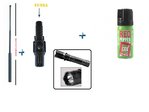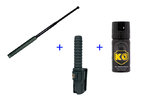The TASER Pulse stun gun is highly effective and reliable on defense.
It overwhelms the attacker with probes fired up to 4.6 m away, striking him with a current of 50,000 V and intensity of up to 10 mA. Currently, it is one of the best defense devices in the world.
Taser Pulse is the first compact stun gun on the market, confusingly resembling a firearm, capable of incapacitating a potential attacker at a range of up to 5m for 30 seconds.
The intensity of the current is less than 10 mA, so that for its purchase and possession by adults a permit is not required in accordance with the Arms and Ammunition Law in most of the European Countries:
Art. 11 point 7:
"electricity with an average value of the current in the circuit not exceeding 10 mA".
The device has:
- a laser pointer for the target
- a double-sided fuse
- a replaceable cartridge with a probe range of 4.6 m
- a flashlight that illuminates the target and its surroundings
- a front sight and a rear sight to help aim
What is the TASER Pulse incapacitation device?
The TASER Pulse is an electrically incapacitating device for self-defense manufactured by TASER International Inc USA.
TASER line devices operate by conducting electricity through wires or by direct contact.
The current affects the sensory and / or motor functions of the nervous system.
The Pulse device uses replaceable cartridges containing pressurized nitrogen to fire two small probes connected to the cartridges with insulated lead wires with a maximum length of approximately 4.6 meters.
The Pulse device sends electrical impulses through wires to the body that, if used successfully, will affect the sensory and / or motor functions of the peripheral nervous system, immobilizing the body.
The
TASER technology for neuromuscular incapacitation (NMI) uses electrical impulses similar to those of the nervous system to stimulate sensory and motor nerves.
Neuromuscular incapacitation occurs when the DEC device causes sensory and motor nerves to be involuntarily stimulated, leaving the attacker temporarily out of control over bodily movements.
It has nothing to do with the sensation of pain and can also be used successfully in people with a high pain tolerance threshold.
Previous models of disabling devices mainly affected the sensory nerves, basing their principle of action on the induction of pain.
A person with a very high pain tolerance threshold (for example, under the influence of drugs, under severe stress, or a focused, trained warrior) may not be affected by pain or may be able to fight despite pain caused by a traditional disabling device.





